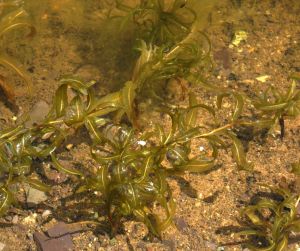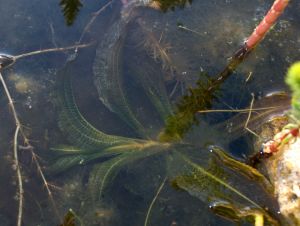Ok, so here we go with the plants. And yes, I admit it, I really like pondweeds. Now, I hear you say, I’d already worked that out as this thing is about ponds. Of course you like pondweed. But I don’t just mean any old pond plant – I mean proper pondweeds, Potamogeton.
There are 21 different species of Potamogeton native to Britain. They interbreed with great frequency and thoroughness, so a further 27 hybrids have been found, and no doubt a few more remain to be discovered. How many of these are in general cultivation? Well, according to the 2006-7 edition of the Plant Finder (the most recent copy I have) there are two. Why this is I have really no idea. However, it is certainly true that the water garden industry generally grows a rather small and conservative range of plants, especially submerged species (or ‘oxygenators’ as they are misleadingly sold – in fact ponds do not depend on submerged plants for their oxygen). Potamogetons don’t seem to have come onto the radar. I think that’s a pity, because these plants have a quiet beauty, are great for wildlife and add a range of textures to the garden pond.
From a horticultural point of view, pondweeds come in three basic flavours: floating-leaved, submerged broad-leaved, and submerged fine-leaved. The floating-leaved and broad-leaved types both grow from perennial rhizomes (roots) that creep across the bottom of the pond and send up stems every so often. On the other hand, the fine-leaved types die back in winter to clusters of unattached resting buds called turions that disperse around the pond. It’s therefore probably best to think of most of the fine-leaved types as ‘annuals’ (there are a couple of exceptions).

Broad-leaved pondweed growing wild in a pond in South Wales
The floating-leaved group contains just three species, but one of these, the Broad-leaved pondweed Potamogeton natans, is very common and will be familiar to many people, even if they don’t know its name. Here’s a nice patch of it in a pond in South Wales.
Broad-leaved pondweed has a number of merits. It is easy to grow, it has attractive oval leaves that are usually a reddish colour, and it provides shade and a good resting place for damselflies to lay their eggs. However, it is also a vigorous plant that is liable to take over small ponds, including most garden ponds. Unless you are happy to have the surface covered, I can’t really recommend it for any but the largest pond, or possibly ornamental lakes.
Fortunately there are plenty of other species to choose from. I think my favourite, and so far the one that has thrived most in my garden pond, is the Various-leaved pondweed, Potamogeton gramineus. This is quite an uncommon species that naturally grows in rather shallow water in ponds, ditches and lake margins where conditions are not too nutrient-rich.

Various-leaved pondweed growing as the submerged form
Various-leaved pondweed (who comes up with these names?) has transparent submerged green or brown leaves with a prominent white midrib. Later in the summer, or when crowded by other plants it produces a crop of floating leaves that resemble a smaller version of P. natans. In the three years since I’ve planted it, it has romped happily around the pond; however it doesn’t have a dense habit and won’t shade out other species. I haven’t searched but I expect that the broad flattish leaves are ideal for newts to lay eggs in. In deeper water it seems to produce somewhat narrower leaves.

Floating leaf of Potamogeton gramineus
Like most of the broad-leaved pondweeds, Potamogeton gramineus is easy to grow. You need to obtain a piece of the plant with some rhizome attached to it (the bigger the piece of rhizome the better) and not too much leaf. Weight it down to the bottom of the pond with a stone or similar object (you can use a garden gnome if you wish!) so that the rhizome is in contact with some sand, fine gravel or whatever rooting material you have. Then just let it do its thing.
Now at this point I feel the need to mention two of my bugbears regarding pond plants. The first one is those funny little plastic mesh baskets that water gardens like you to buy to put plants in. Why is this considered attractive? On land containers tend to be an option of last resort when you don’t have space for a border, but for some reason water gardeners convince themselves that pond plants need to be confined. Now it’s true that pond plants tend to be quite vigorous, but unfortunately most of them are also quite capable of escaping the confines of a container after a few years. Much better to dispense with these environmentally unfriendly eyesores and just plant direct into the substrate.
My other bugbear is the perception (especially for ‘oxygenators’) that you can just throw a bunch of plants into the water and they will establish. Now, for the restricted range of these plants widely available to gardeners – things like Canadian pondweed or curly waterweed – this happens to be true, because they are so invasive that they will establish pretty much regardless of how they are treated. But the majority of plants – including native submerged species – need to be properly planted with the roots attached to the substrate. After all, you don’t plant your lettuces out by just throwing the plants on the surface of the soil, do you?
The final pondweed I’m going to write about today is the shining pondweed Potamogeton lucens. This one is really very attractive and is a beautiful contrast to the normally rather fine-leaved plants growing in ponds such as water milfoils. It has large, broad, translucent leaves that are much larger than various-leaved pondweed (up to 25cm long and 6.5cm wide, though in my pond they are more like 12 x 3cm).

Shining pondweed, Potamogeton lucens
The leaves are translucent green and have a netted appearance, and the new stems have a lushness that gives an almost tropical feel. In the wild this plant prefers still or slow-flowing, calcareous water and usually grows in at least 1m or so depth. Here in Wales this is a rare plant but it’s reasonably common in south-east England where suitable habitat is more frequent.
Although it prefers deep water in the wild, I planted my pieces in water only 10cm or so deep, from where it is spreading steadily into deeper water. Like most of the broad-leaved pondweeds it takes a year or so to settle down and start growing strongly in the pond. For me this species is reason enough to have an area of deeper water in the pond (50cm or more deep) where it can grow happily. According to one reference I have the stems of this species can reach 6m, so depth should not be a problem!
I have seen shining pondweed in cultivation in Holland, growing in a small pond in spite of the attentions of goldfish and a strong green colour to the water. If you can get hold of some I can recommend it. It should be planted in the same way as P. gramineus.













